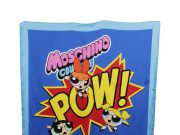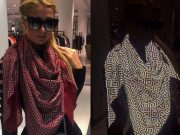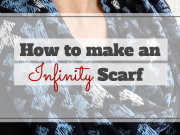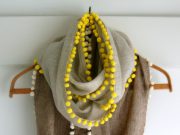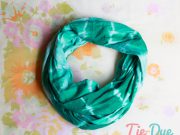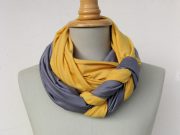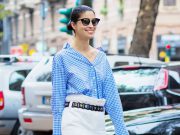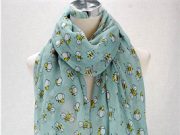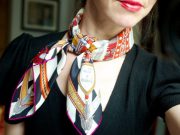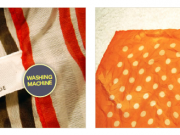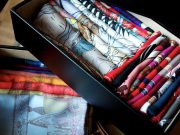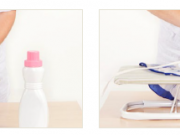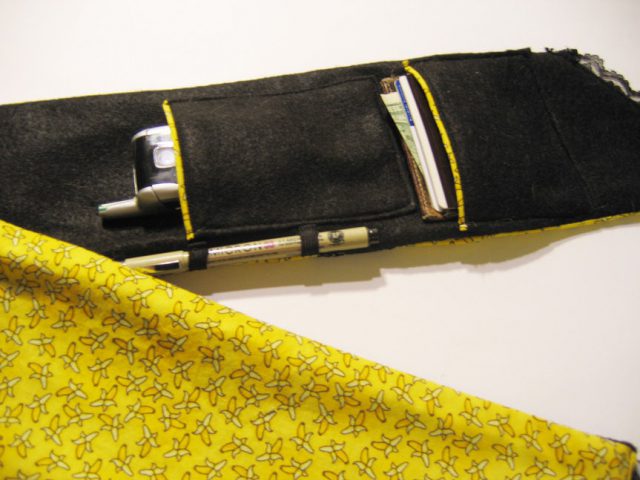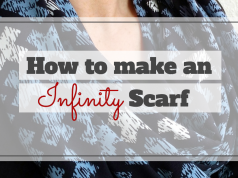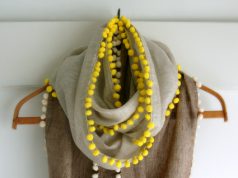Step 1: Materials
1/2 yard 45″ wide cotton for outer layer
I chose a cute banana-print cotton; any decorative or fashion fabric will do, but it should be woven (not a stretchy knit).
1/2 yard lining
This is the part of the scarf that will be against your skin, so choose something warm and comfortable. Softer felts, flannels or fleeces are all good options.
Decorative trims
These can be lace, eyelet tape, or whatever else you prefer. If you plan to adorn all the edges, you will need 4 1/2 yards of trim for a 68″ scarf. To decorate only the short edges, 1/2 to 3/4 of a yard will do; vertical accents will require 2 yards of trim each, and horizontal accents will only require 6 inches of trim each.
D-ring and nylon webbing
These are for creating a decorative accent and/or ring to clip your keys to. You can substitute the nylon webbing (only a few inches are needed) with a piece of matching or contrasting fabric.
Narrow Elastic
This is for constructing a pen or pencil sleeve. You only need a few inches; choose a color that complements your lining and fashion fabrics, as it will be visible.
Bias square, measuring tape, or ruler
Chalk or marking pencil
Sewing Machine
This project can sew by hand with a needle and thread, but a machine will make it much faster and easier.
Pins
Iron
Step 2: Mark and Cut Fabric
B) Cut two identical strips from the edge of the lining fabric.
Step 3: Sew Strips
Try on one of the strips to determine the desired length for your scarf, and mark. Lining the two strips up, right sides together, trim one end at an angle at this point. Mine is 68″ on the longest side; you can keep yours longer if you prefer.
Step 4: Draft Pocket Patterns
Step 5: Sew Pockets
For each pocket, cut a strip of fashion fabric 1 1/2 inches wide, and as long as the top edge of the pocket. Place these strips right-side together with the pocket pieces, and stitch 5/8″ from the edge. Fold the seam open as shown, press, and turn the edges to the wrong side of the pocket, leaving a small (about 1/4″) line of fashion fabric visible on the right side. On the right side, stitch along the first seam, securing all the loose fabric edges to the wrong side of the pocket.
Fold in the other sides of the completed pocket, 5/8″ from the edges, and secure with pins. Pin to the right side of the lining strip in the desired location, keeping in mind that the outer 5/8″ of the strip should be left clear for the seam allowance. Stitch the pocket in place, approximately 1/4″ from the pocket edge.
Step 6: Sew Pen Holder
First, stitch down one folded edge of each piece. Next, push up the centers of the elastic strips so that they form small arches just large enough to hold a pen snugly (as shown), and stitch the remaining edges. Test your pen holder to make sure the arches are the right size for a pen or pencil; if they are too loose or too tight, take out the second set of stitches, adjust the elastic, and sew again.
Step 7: Attach Key Ring and Trim
Sew the webbing in place, coming as close to the D-ring with your stitches as possible.
Once the D-ring and webbing are attached, sew on any decorative trim you plan to use on either front or back surfaces. You don’t need to attach trim that will decorate the very edges of the scarf; this will come after you’ve sewn the two faces together.
Step 8: Assembly
Place the two strips right side together, and stitch along the two long edges and the angled short edge, leaving a 5/8″ seam allowance. Turn right side out, push out corners, and press flat.
Fold in the raw edges on the open end; press flat and topstitch. This is a good time to sew any trim to the edges; simply pin to the back if you only want the edges of the trim to show (as with lace), or pin to the front if you want all the trim to show (as with eyelet tape). Then, topstitch to secure.


